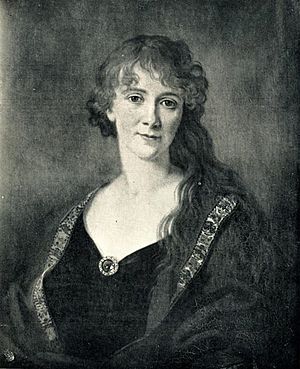Martha Wilmot facts for kids
Quick facts for kids
Martha Wilmot
|
|
|---|---|
 |
|
| Born | 1775 Glanmire, County Cork, Ireland |
| Died | 18 December 1873 (aged 97–98) Taney Hill house, Dublin |
| Occupation | writer |
| Nationality | Irish |
| Period | 18th century |
Martha Wilmot (1775 – 18 December 1873) was an Irish traveler and writer. She was known for her diaries and letters, especially about her time in Russia.
Martha Wilmot's Early Life
Martha Wilmot was born in 1775 in Glanmire, a place in County Cork, Ireland. Her parents were Edward and Martha Wilmot. She grew up with five sisters and three brothers. Her father, Edward, was from England. He had been a captain in the army and later worked as a surveyor in Cork and Drogheda. Martha was taught at home. In 1802, after her brother passed away, her cousin suggested she visit a friend of her brother's. This friend was a very important person: Princess Dashkova of Russia.
Adventures in Russia
Martha Wilmot started her long trip to Russia in 1803. Her journey took four months. She traveled to the princess's country home, called Troitskoe. While living there, Martha joined in with the princess's daily life. She became a very close friend and trusted helper to Princess Dashkova.
During her travels with the princess, Martha met a man named Aleksei Orlov. To honor Martha, he even had his soldiers put on a pretend battle! Martha wrote in her diary every day and sent many letters home to Ireland. She also encouraged the princess to write her life story. Princess Dashkova did this and dedicated her book to Martha, calling her "my young friend." She also gave Martha permission to publish the book.
In 1805, Martha's sister, Katherine, came to Russia to bring Martha home. But Katherine ended up staying as a guest for two more years! Martha and Katherine often visited Moscow. Martha copied the princess's life story by hand. Her sister Katherine translated it from French into English. In 1807, the Wilmot sisters learned they might be in danger. The princess's daughter, Madame Shcherbenin, was suspicious of them. So, Katherine left Russia, taking the translated copy of the memoirs with her.
In 1808, Martha had to leave Russia because England and Russia started fighting. Princess Dashkova did not want her to go. She gave Martha many gifts, including a watch that belonged to Peter the Great and a fan from Empress Catherine. As Martha was leaving St Petersburg, customs officials stopped her. They thought she might be carrying secret papers. Fearing for her safety, Martha burned the original copy of Princess Dashkova's memoirs. She also burned some letters between the princess and Empress Catherine.
On October 26, 1808, Martha sailed on a ship called the Maria. But the ship was wrecked! Martha spent eight days on an island near Hamina, Finland. Then, she and the other passengers had to wait out a storm for three weeks on another island. Finally, she reached Harwich, England, on December 26, 1808. She arrived back in Cork, Ireland, by 1809.
Life After Russia
The summer after she returned, Martha Wilmot explored the southwest of Ireland. In 1810, she was introduced at the lord lieutenant's court in Dublin Castle. There, she met Sydney Owenson, who would become a famous writer.
In 1810, Martha moved to Clifton, Derbyshire to live with her parents. In 1812, she married Rev. William Bradford. They had one son and two daughters and lived in Sussex Downs, Storrington. Martha traveled to France with her sister Katherine in 1817.
In 1819, Martha's husband became a chaplain for the British embassy in Vienna, Austria. So, the family moved there. They lived in Vienna for ten years. They became friends with the British ambassador, Charles William, and his wife, Frances Vane, Marchioness of Londonderry. From 1820 to 1821, Martha and her family toured Italy. Her diaries from this trip are now kept at the Royal Irish Academy (RIA). In 1829, her husband was appointed chaplain to King George IV. The family then moved back to Storrington.
In 1840, Martha Wilmot's version of Princess Dashkova's memoirs was published in English. It was called Memoirs of the Princess Daschkaw, lady of honour to Catherine II, empress of all the Russias, written by herself. Martha had waited a long time to publish it. This was because Semyon (Simon) Vorontsov, Princess Dashkova's brother, was against it. He had been the Russian ambassador to Britain for twenty years. Martha's book was based on her copy and her sister's translation. It was a shorter version of the original. Later, this book was translated into French, German, Russian, and Czech.
Later Years and Legacy
After her husband passed away in 1857, Martha Wilmot moved back to Ireland. She lived with her daughter, Catherine, at Taney Hill house in Dublin. Martha died there on December 18, 1873. She is buried in the churchyard in Storrington, England.
Martha and her sister's diaries were later put into books. In 1934, The Russian journals of Martha and Catherine Wilmot was published. This book used their original letters, notes, and diaries. These papers are kept at the Royal Irish Academy. The next year, another book was published: More letters from Martha Wilmot: impressions of Vienna, 1819–1829. The Royal Irish Academy still holds many of Martha's papers, including some that have not been published.
Martha Wilmot's daughter gave the copy of Princess Dashkova's memoirs to the British Museum library. This copy included changes made by the princess herself. This manuscript was used for a new translation of the memoirs in 1958. Another copy of an earlier version of the memoirs, written in Martha's own handwriting, is kept in St Petersburg, Russia.

